Junction box for indoor and outdoor wiring: types, classification + installation instructions
A traditional element of electric networks is a junction box for external and hidden wiring, which protects current-carrying conductors (cables) at their connection points. It has a simple design and does not cause difficulties with installation, the main thing is to choose the right accessory. But this issue should be given special attention.
Choosing an electrical element, it is necessary to take into account a number of important parameters. Among them: the type of wiring, the material of the walls and the junction box itself, as well as other factors.
We will tell you how not to get confused in the variety of offers, help you choose the best option and perform competent installation.
The content of the article:
Classification of junction boxes
Designs of different configurations are suitable for mounting on materials of various types - brick, concrete, drywall, etc. This type of electrical accessory is actively used in installation of home wiringwhat ensures electrical and fire safety.
Based on the purpose, electrical distribution boxes should be conditionally divided into two types:
- Desoldering. Their mission is to protect wires and cables from a humid environment and mechanical damage during operation of a household power supply circuit.
- Installation. They are used to create convenient communications during installation work related to the installation of electrical equipment.
Both types of products may be used at ambient temperatures from –25 to + 40ºС.
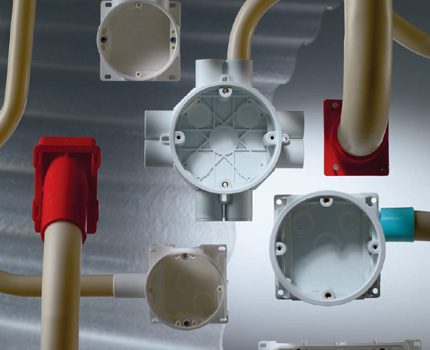
The advantages of using junction boxes are obvious:
- wide selection for different power grids;
- reliable protection of electrical wiring joints;
- Convenience and ease of installation;
- a variety of body materials;
- a variety of decorative designs.
The design of the products is simple and usually represented by boxes of rectangular, round or other shape, which are closed with lids. Tight fit and fixing of the covers is provided by locks-latches of various configurations.
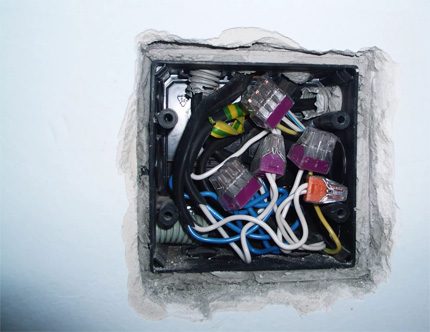
All existing forms of boxes are made for concealed or open installation. The fastening of the junction boxes of the outdoor installation is carried out as standard - with screws, dowels, self-tapping screws.
Fixing the junction boxes for hidden wiring is done by inserting them directly into the structure of the building structure (wall, partition, ceiling), followed by pouring the solution.
Designs for open wiring
Execution box mounting open wiringusually rectangular or round. Production material - polypropylene, ABS plastic in white, gray or black. The number of side openings for wire entries (cables) from 4 to 10.
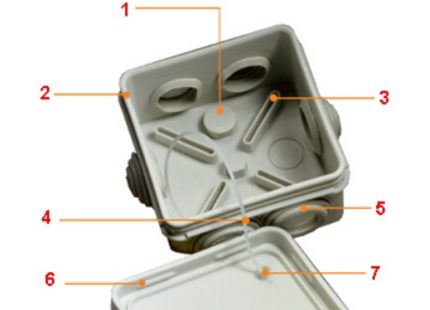
As an illustrative example of an open wiring box, you can consider the AP9 model, designed for installation in rooms with high humidity. The body of the product is made on the basis of two-component casting and is equipped with membrane entries for the cable.
The upper case (cover) of such junction boxes, made for external installation, has on the inside a special groove around the entire perimeter. A PVC seal is laid in this groove, reliably blocking the path of moisture and dust penetration into the product.
The cover is “tied” to the case with a flexible leash - an additional convenience during maintenance.
Despite the simple execution, the design features of boxes like the AP9, provide such products IP degree of protection 55. The design is supplemented with accessories - fuses, terminal blocks, which provides a more convenient and reliable connection of conductors.
Hidden products
Hinged boxes for concealed wiring actually have the same technical parameters and qualities that are noted for outdoor mounting products. They are also mainly made of polypropylene and polystyrene. Moreover, polypropylene, as a rule, is used to make the case, and polystyrene is the cover material.
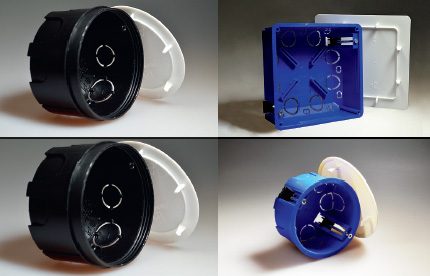
For installation in the body of brick and concrete walls, junction boxes are produced that have a protection class of IP20 - IP30. The shape of the products is mainly round or rectangular. The color of the case is white, blue, black. Covers are traditionally white or light gray.
The articulation and fixation of the cover with the housing is usually done by means of a pin lock. On the case there are grooves where plastic cover pins are inserted.
Mounting Box - Socket
There is a variety of soldering designs - installation boxes. Their main purpose is to install inside hollow or solid walls of buildings (brick, concrete) with the subsequent installation of electrical switches, sockets and other elements of electrical networks. Mounting junction boxes are manufactured to IP20.
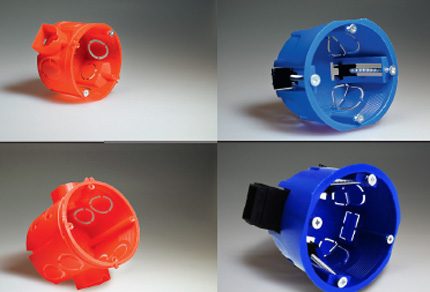
Branded products are made of good quality plastic, which has high strength and dielectric protection characteristics.
Mounting boxes can be mounted at ambient temperatures from -5ºС to + 60ºС. The range of operating temperatures is within the range of -25ºС / + 40ºС. There are two types of products: for installation in hollow walls or in solid walls.
The connections inside the junction box are simpler, better, faster using spring terminals:
Designs differ from one another in fixing technique:
- fasteners with support legs;
- fasteners with mounting dowels or screws.
Read more about installing teasers in this article.
There are also differences in the degree of rigidity of the body and color. For solid walls, structures usually have a more rigid body and are painted red.
What is the difference between metal products
Cable connection points for lighting wiring, as well as power lines rated for a voltage of no higher than 1000 W, are often arranged inside metal junction boxes.
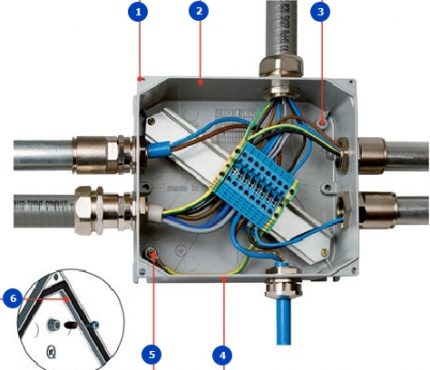
The metal configuration is a kind of universal option for such products.
These boxes can be used not only for AC or DC networks, but also for networks:
- telephone;
- television;
- computer;
- informational.
Metal boxes are made on the basis of alloys with chemical and corrosion resistance. The external surface is coated with a special epoxy resin, which provides additional mechanical strength and UV protection. From 2 to 6 entries with threaded fittings may be present on the housing.
In the closed state, the ingress of foreign matter into the metal box is excluded due to the high-quality sealing of the lid and cable entries. Installation of boxes of this configuration is permissible indoors and outdoors.
They are mounted, as a rule, in combination with rigid metal pipes acting as cable channels. Protection class of products IP66 - IP67.
DIY installation instructions
When purchasing products for installation, it should be borne in mind: each branded product is usually packaged and accompanied by a product label.

The product label indicates: technical information, product barcode, certification mark.
Tools and materials for installation
To carry out installation work on the installation, the electrician will need a standard tool kit in such cases:
- pliers;
- cross-shaped screwdriver;
- a knife with a thin sharp blade.
Set of mounting accessories:
- insulating tape;
- electrical terminals;
- DIN rails
- fasteners - screws, screws, dowels, etc.
It should be noted: installation work related to the laying of electrical networks and associated valves is allowed to be carried out only by persons with relevant knowledge and qualifications.
In extreme cases, you can do the installation of the boxes yourself, lay cable channels. But connections, connection, testing on electric networks, according to the instructions, are allowed to be carried out only by authorized persons.
Installation of valves of various types
Outdoor mounting:
- On the case of the junction box, cut off the seals of the airtight entries with a sharp thin knife. Slices are made along the marking lines on the cork in accordance with the diameter of the cable channel or the cable itself.
- Tubular channels — corrugated or straight plastic tubes — are introduced into the holes formed after the cuts.
- Through the channels, lead the ends of the wire into the case of the junction box.
If necessary, install terminal blocks in special guides and connect the conductors according to the scheme. At the end, close the junction box with a lid, pressing it with some force until completely locked with locks.
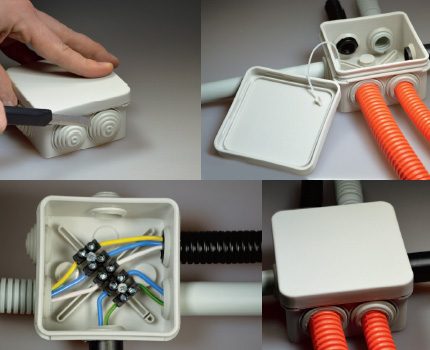
Installation instructions for the external universal box under the cable channel:
- Make standard cuts on the case of the box with cuts with a knife for the size of a rectangular cable channel. Standard tags are designed for docking with cable channels with a cross section of at least 10 * 7 mm, maximum 40 * 25 mm.
- Carefully break off the incised part of the plastic housing, thus obtaining an opening for the cable channel.
- On the base of the universal box, fix the terminal blocks for the mechanical bundle of electrical conductors.
Laying electrical wiring through the cable channel, connect the ends of the conductors according to the scheme on the terminals.
At the end of the work, install the box lid and fix it with a fixing screw.
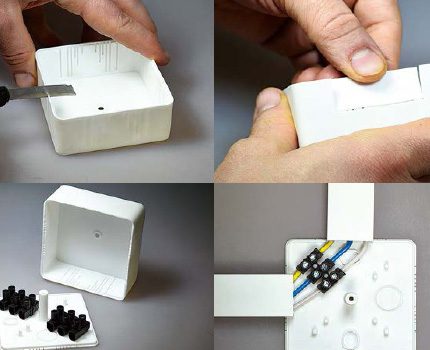
Installation procedure for the installation (hidden) box:
- Prepare the product by pre-harvesting the required number of inlets in the housing. Holes are created by breaking the edges of the finished stencil. Up to 11 stencils for inlet openings can be placed on the housing of the installation box.
- Make a landing hole in a hollow wall, for example, in plasterboard, using a cutting crown for the diameter of the product. Or use the finished landing hole in the solid wall.
It remains to bring the cable channels with the wire, combine them with the box, output the ends of the wiring for the connections and fix the case of the box by distributing the fixing paws with screws (for drywall) or pour solution.
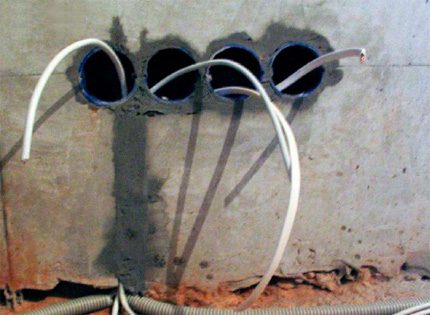
Having connected the conductors of the hidden trunk in accordance with the wiring diagram, close the box (s) with a lid. Externally, this design successfully fits the existing interior.
The following selection of photos will present the steps for assembling the Wago brand junction box:
Mounting a metal junction box
The execution of metal junction boxes provides only external installation of such products.
Therefore, the instruction, in this case, is simple:
- Bring tubular channels with a wire to the entry points.
- Perform mechanical threaded fastening of pipes to the walls of the housing and the conclusion of the ends of the cable in its inner region.
The box body is fixed to the wall with screws through the holes designed for fasteners. Then connect the cables according to the scheme, cover the box and fix the cover with screws.
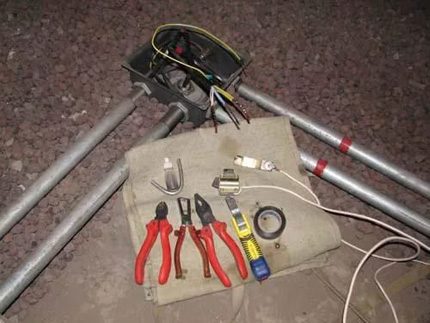
Something like this is the installation of distribution modules with different designs.
More installation examples can be seen in the video.
Conclusions and useful video on the topic
Visual instruction for mounting the junction box:
It is not possible to cover all existing design variations of junction boxes in one review. But the principle of the device and the installation features for all existing products are almost the same.
Therefore, these instructions can be considered as universal for installing many models of junction boxes.
Those interested in the question of choosing and installing junction boxes we suggest leaving comments, asking questions and participating in discussions. The feedback form is located in the lower block.

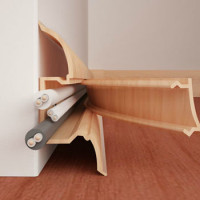 Cable channel for electrical wiring: types of structures and their classification
Cable channel for electrical wiring: types of structures and their classification 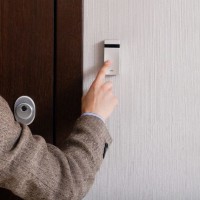 Setting a call to the apartment: overview of schemes + step-by-step installation instructions
Setting a call to the apartment: overview of schemes + step-by-step installation instructions 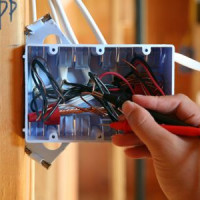 Which wire to use for wiring in the house: recommendations for selection
Which wire to use for wiring in the house: recommendations for selection 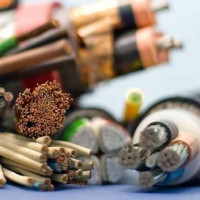 Wire cross section for home wiring: how to correctly calculate
Wire cross section for home wiring: how to correctly calculate 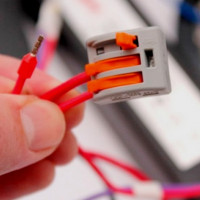 Wire connectors: the best types of connectors + what to look at when choosing a connector
Wire connectors: the best types of connectors + what to look at when choosing a connector 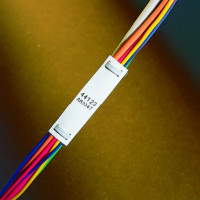 What cable to use for wiring in the apartment: a review of the wires and choosing the best option
What cable to use for wiring in the apartment: a review of the wires and choosing the best option  How much does it cost to connect gas to a private house: the price of organizing gas supply
How much does it cost to connect gas to a private house: the price of organizing gas supply  The best washing machines with dryer: model rating and customer tips
The best washing machines with dryer: model rating and customer tips  What is the color temperature of light and the nuances of choosing the temperature of the lamps to suit your needs
What is the color temperature of light and the nuances of choosing the temperature of the lamps to suit your needs  Replacement of a geyser in an apartment: replacement paperwork + basic norms and requirements
Replacement of a geyser in an apartment: replacement paperwork + basic norms and requirements
In my practice, I use all the useful factors that the wiring of wiring boxes carries. Here, in my opinion, an important nuance is indicated very briefly: selection of the shape, material and color of the box for interior design. Such things must be negotiated with customers. In production facilities, corrugated boxes are most often used.
If a highly branched wiring diagram is designed in the customer’s house, then such boxes greatly help out in work. They can even be placed near the pool. The risk of fire even in this case is excluded. But I like more that the boxes are easy to put inside the partition. After connecting the wires, it is not necessary to treat them with non-combustible material: clay, or plaster, as it was in the Soviet years. Although their design is simple, how many problems can be avoided!
Good day, Sergey.
In the Soviet years, junction boxes were always used in the construction of houses - there were no electricians who “worked on connecting wires” with clay or plaster. Of course, I realized that you did not have enough professional terms.
By the way, for the repair of such products was really not enough. They found a way out - they made a recess in the wall under a suitable tin can and monolized the side voids with stucco (previously cut holes through which the wires were led). Some craftsmen, when the solution was set, pulled the jar - a cylindrical cavity was obtained for connecting the wires.